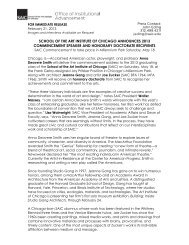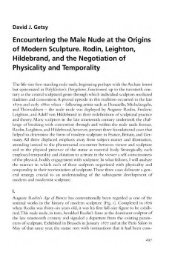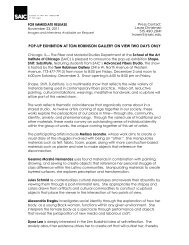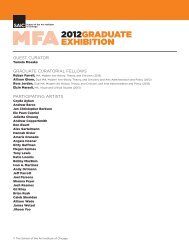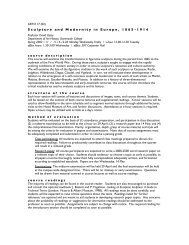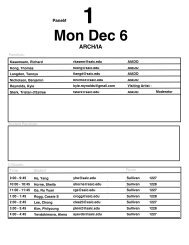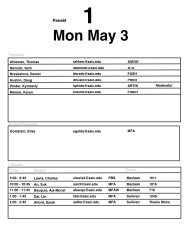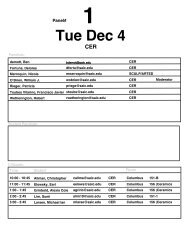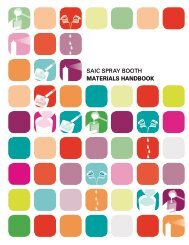i. institutional support and commitment to continuous improvement
i. institutional support and commitment to continuous improvement
i. institutional support and commitment to continuous improvement
You also want an ePaper? Increase the reach of your titles
YUMPU automatically turns print PDFs into web optimized ePapers that Google loves.
School of the Art Institute of Chicago<br />
Department of Architecture, Interior Architecture, <strong>and</strong> Designed Objects<br />
Master of Architecture<br />
Master of Architecture with emphasis in Interior Architecture<br />
o Spring 2010: Frank Hertzman, the IDP coordina<strong>to</strong>r for Illinois, was a guest speaker in ARCH/<br />
INARC 6123 Codes, Specs, Joints, <strong>and</strong> Seams <strong>to</strong> discuss internships with the second-year<br />
Architecture <strong>and</strong> Interior Architecture students <strong>and</strong> first-year Interior Architecture students.<br />
o Spring 2010: Ten SAIC students (primarily first <strong>and</strong> third year) attended a special IDP evening<br />
event for students <strong>and</strong> interns at the AIA Chicago, led by NCARB staff <strong>and</strong> Frank Hertzman.<br />
o Summer 2010: SAIC representatives (students <strong>and</strong> IDP coordina<strong>to</strong>r faculty) attended two<br />
IDP events that <strong>to</strong>ok place beyond SAIC.<br />
o Summer 2010: Professor Sterk attended the IDP coordina<strong>to</strong>rs conference in Chicago <strong>and</strong><br />
gained access <strong>to</strong> AIA IDP coordina<strong>to</strong>r resources.<br />
o Fall 2010: Presentation by NCARB Illinois on professional licensure <strong>to</strong> MArch students.<br />
2) Education for the practice of architecture<br />
The sixth semester ARCH/INARC 6222 Sustaining Practice Economies is taken by all tracks in the MArch<br />
program. It covers a wider range of material than the IDP <strong>and</strong> architectural registration, but it clearly repeats<br />
<strong>and</strong> reinforces the information first delivered in the course ARCH/INARC 6123 Codes, Specs, Joints, <strong>and</strong><br />
Seams. Other <strong>to</strong>pics in ARCH/INARC 6222 Sustaining Practice Economies include:<br />
o A survey of the his<strong>to</strong>ry of practices<br />
o conventional/alternative practices (with field trips <strong>to</strong> a local cross-section of office sizes <strong>and</strong><br />
types)<br />
o IDP, ARE, registration, licensure, reciprocity, <strong>and</strong> continuing education, as well as the roles<br />
<strong>and</strong> resources of the AIA <strong>and</strong> NCARB<br />
o business, contracts, termination, errors <strong>and</strong> omissions, insurance, binding arbitration, waivers,<br />
<strong>and</strong> certificates<br />
o relationships with consultants<br />
o job research <strong>and</strong> search.<br />
3) Education by professional architects<br />
The central location of the AIADO program in Chicago’s Loop facilitates professional architects contributions<br />
<strong>to</strong> the education of MArch students. Some practicing architects serve as long-time adjunct faculty members<br />
teaching particular classes for years. Despite busy schedules, other practicing architects teach single classes<br />
in collaboration with AIADO faculty members. In Fall 2010 Brian Vitale from Gensler is co-teaching with<br />
Professor Linda Keane in the first semester architecture design studio. Practicing architects also join regular<br />
academic critiques at the mid- <strong>and</strong> endpoint of each academic term.<br />
4) Education by consulting professional engineers <strong>and</strong> experts<br />
The Integrated Technical Practice thread of five sequential classes gives professional engineers <strong>and</strong> experts<br />
substantial time in class <strong>to</strong> overlap <strong>and</strong> collaborate with architectural faculty members while teaching.<br />
This class structure presents a genuine reflection of the way generalist architects, experts, <strong>and</strong> engineers<br />
collaborate in professional offices. Examples include professional structural engineers, professional BIM<br />
experts, electronic systems <strong>and</strong> programming experts, <strong>and</strong> HVAC experts—all of whom regularly teach in<br />
required courses in the MArch program side by side with architects. A long-term teaching relationship has<br />
been developed between AIADO department <strong>and</strong> Thorn<strong>to</strong>n Thomasetti structural engineering, <strong>and</strong> the<br />
department plans <strong>to</strong> exp<strong>and</strong> its regular teaching relationships <strong>to</strong> include other firms such as Skidmore,<br />
Owings & Merrill LLP; Gensler & Associates; <strong>and</strong> O’Donnell, Wicklund, Pigozzi & Peterson Architects, Inc. The<br />
goal in this integrated teaching structure is <strong>to</strong> present basic engineering ideas <strong>and</strong> methods in a context<br />
where they are heard, unders<strong>to</strong>od, <strong>and</strong> incorporated in<strong>to</strong> the course assignments by the architectural faculty<br />
who remain present throughout the class, thereby legitimating the engineering knowledge for the students.<br />
Architecture Program Report | 24



